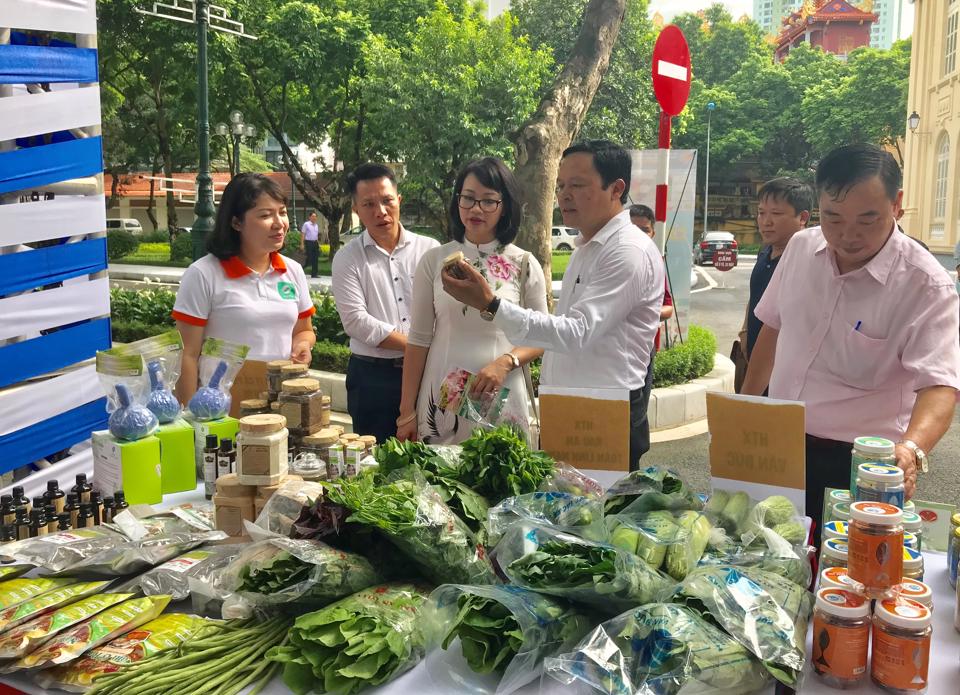Hanoi promotes brand-building for agricultural products
Products with brands and clear origin are 15-20% more expensive than those without brand protection.
Hanoi is working with other localities to promote branding for agricultural products, which is a key step in raising their value in the domestic market and, subsequently for export.
| Hanoi's farm produces in a trade fair. Photo: Anh Ngoc |
The Director of the Van Nam Agricultural Cooperative in Phuc Tho District, Doan Van Thang, said that more and more locals and cooperatives in Hanoi are aware of the need to create a brand and protect agricultural products.
According to Thang, the cooperative’s bananas have completed brand registration at the Intellectual Property Office of Vietnam under the Ministry of Science and Technology.
“The high quality of bananas and a strong brand awareness among the customers help boost product sales at supermarkets and convenience stores,” Thang added.
To further enhance the product quality, Thang said the cooperative had invested VND150 million (US$6,048) in building a cold storage system to preserve the product better and boost revenue.
According to Director of Tam Hung Agricultural Services and Businesses Cooperative in Thanh Oai District Do Van Kien, its Boi Khe fragrant rice brand has further expanded its market reach and becomes consumers’ favorite.
The cooperative’s products, including glutinous rice and the Northern fragrant rice No.7, are sold at VND30,000 (US$2.2) and VND18,000 (US$0.5) per kilogram, respectively.
“Thanks to the brand, we are currently long-term partners of many collective kitchens and kindergartens in the city,” Kien said.
Deputy Director of the Hanoi Department of Agriculture and Rural Development Nguyen Ngoc Son said that branding and brand development processes play a crucial role in agricultural production and improve market access for agricultural products, especially as they guarantee product quality and safety.
Son added the city has so far built brands for 40 farm produce, including Dai Thanh late ripening longan (Quoc Oai District); Boi Khe fragrant rice (Thanh Oai District); Van Nam banana (Phuc Tho District); Van Dinh duck (Ung Hoa District); Ba Vi chicken (Ba Vi District).
“Products with brands and clear origin are 15-20% more expansive than those without brand protection,” Son said.
In addition, Son noted that collective brand building would help cooperatives and farmers move from traditional production methods to a closed model with better quality control and safety standards.
“No doubt a product with the brand name would enhance its competitive edge compared to others,” he continued.
Keeping momentum in brand building
While such clear benefits of brand building are obvious, many individuals, organizations, and businesses have not been aware of the significance of such a process.
Meanwhile, several cooperatives still lack market understanding and fail to realize the urgency to further improve product quality to protect their brands.
Chairman of the Farmers Association at Tien Duong Ward, Dong Anh District, Doan Quang Hoai, attributed the poor brand building among cooperatives and farmers to the small-scale and fragmented productions.
“Local authorities should be more active in changing their mindset concerning building brands for local specialties,” Hoai said.
In addition, he continued that owners of brands should be responsible for taking care of their brand names and strictly dealing with abusing brand names for illegal gains.
Sharing Hoai’s view, Director of the Hanoi’s Department of Agriculture and Rural Development Chu Phu My said brand development has always been a challenging task.
My added that the authorities are working on policies to further encourage agricultural production under value chains along with brand building and development.
“Hanoi has been cooperating with neighboring cities/provinces in holding trade fairs and showrooms for high-quality products and facilitating the partnership between distributors and cooperatives to raise brand awareness in the local market,” My said.
Looking ahead, I called on agricultural producers to continue upscale product quality and efficiency by expanding operations, implementing origin-tracing technologies, and complying with food safety standards.
"Only with the consistency of quality and a high level of food safety will local products be able to leverage their brands fully and carve a niche in the market," he said.











